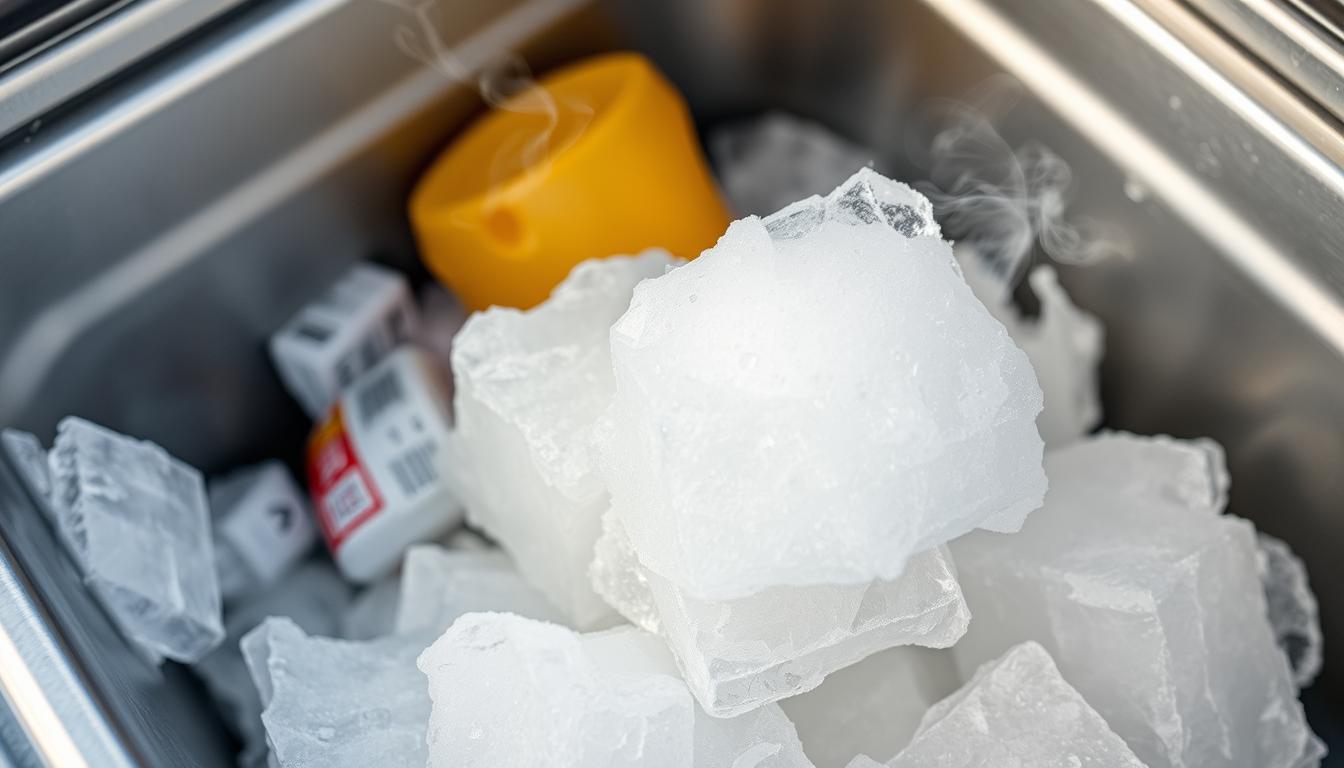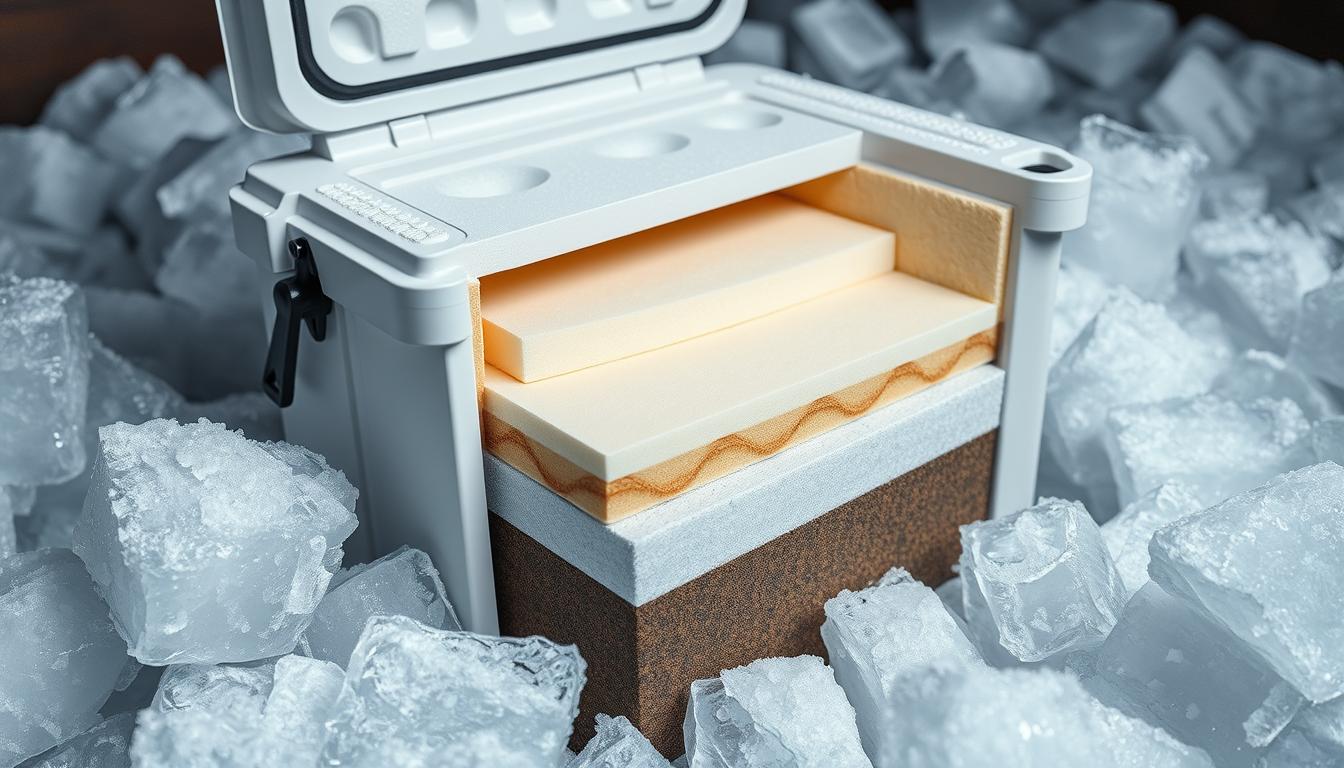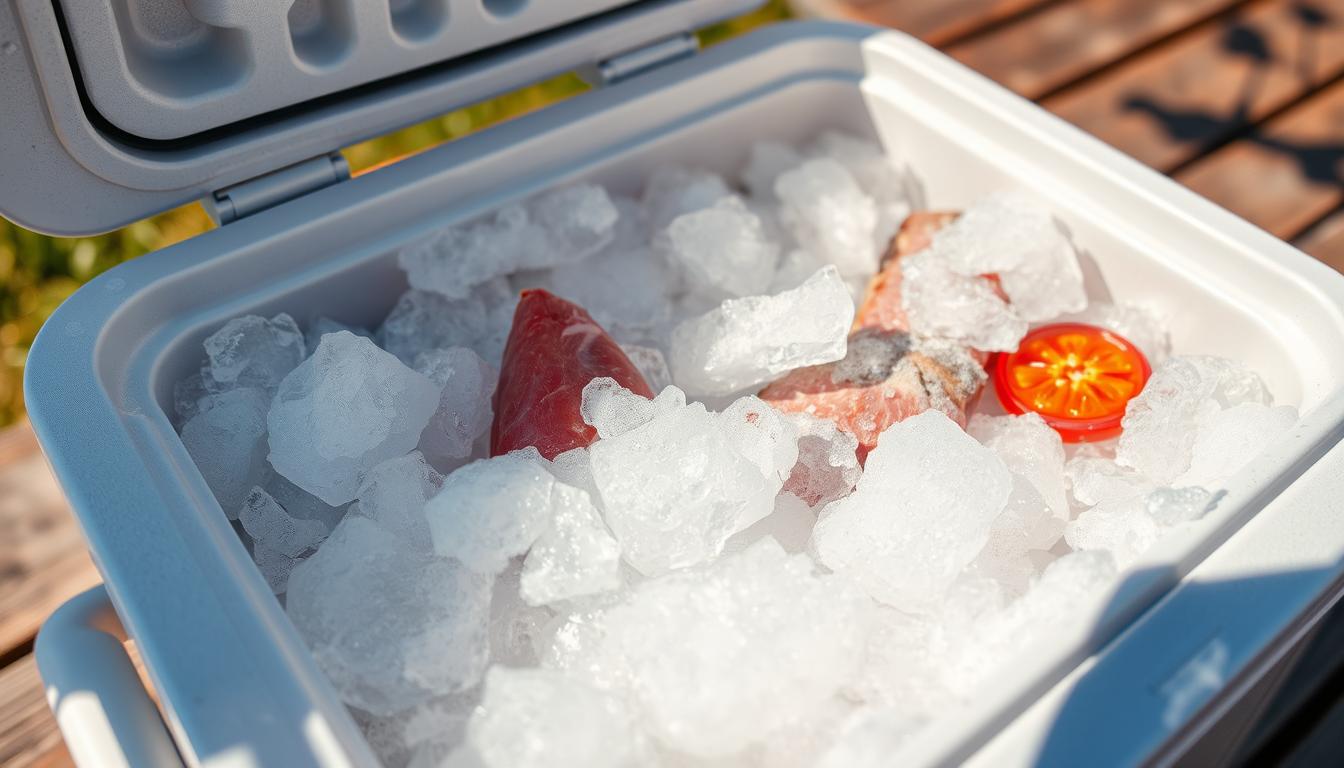Knowing how long dry ice lasts in a cooler is key for those using it for cooling. As dry ice experts, we understand its importance for keeping food fresh. It’s essential for outdoor events, trips, or emergencies. We’ll look into how dry ice keeps things cool and how to keep your cooler contents chilled longer.
So, how long does dry ice last in a cooler? We’ll cover the main factors and share expert advice to extend its use.
Understanding Dry Ice: What It Is and How It Works
Dry ice is solid carbon dioxide, turning straight from solid to gas. This is called sublimation. Unlike water ice, dry ice doesn’t melt into liquid. This makes it perfect for keeping things super-cold without adding moisture.
For cold storage, dry ice is top-notch. It gets as cold as -109.3 degrees Fahrenheit. This cold is great for shipping food, keeping it fresh at outdoor events, and in some industrial uses. Since it doesn’t melt, items stay dry and free from moisture.

The sublimation process lets dry ice turn into carbon dioxide gas. But, this gas can replace oxygen in small spaces, which is dangerous. So, it’s important to store dry ice in a well-ventilated, insulated place, like a cooler, to keep it safe and usable.
In summary, knowing about dry ice means understanding its makeup, how it changes from solid to gas, and its benefits for cold storage. It’s a key tool for keeping things cool in many fields, from medicine to food.
Factors That Affect the Longevity of Dry Ice in a Cooler
Knowing what affects dry ice’s life in a cooler is key. The insulation quality of the cooler is a big deal. Coolers like the YETI Tundra 110 keep things cold for a long time. A recent review shows it’s great for keeping dry ice cold.

The external temperatures also matter a lot. The cooler’s outside temperature affects how fast the dry ice melts. Keep the cooler in a cool, shaded spot to slow down melting.
The quantity of dry ice used is important too. More dry ice lasts longer because it takes more time to melt. Spread the dry ice evenly in the cooler to keep things cold.
How you pack the cooler also matters. Use a barrier, like cardboard or a towel, to keep things cold and protect them from the dry ice.
How Long Will Dry Ice Last In A Cooler?
Knowing how long dry ice lasts in a cooler is key for outdoor adventures or medical transport. The cooling time can change a lot based on the cooler’s quality and the environment. Usually, dry ice can stay cool for 18 to 24 hours in a regular cooler under the best conditions.
But, top-notch coolers can keep dry ice cool for up to 48 hours. The size of the dry ice block matters too; bigger blocks last longer. Using many small pieces will make them melt faster than one big block.
Where you store the cooler affects how long dry ice lasts. Keeping it in a cooler, shaded spot slows down melting. For example, a cooler in a car’s trunk stays cooler longer than one in the sun.
Understanding how cooler quality, dry ice size, and storage conditions work together is key. This knowledge helps predict how long dry ice will last. It makes planning and using dry ice more effective.
In short, using dry ice wisely based on these factors is very helpful. It ensures dry ice stays cool for a long time, making it useful for many things.
Tips to Maximize the Lifespan of Dry Ice in Your Cooler
To make dry ice last longer, start by cooling your cooler before adding it. This reduces the energy needed to keep things cold. This helps the dry ice stay effective for longer.
Good insulation is also key. Choose a cooler that keeps cold well. For more on coolers that keep ice longest, check out this resource. Good insulation keeps cold air in and warm air out.
When packing, put dry ice at the top. This lets cold air sink and cover your food better. Use dry ice packs to keep everything cool.
Keep the cooler lid closed as much as you can. Opening it too often lets warm air in. Plan ahead and keep the lid tight to slow down dry ice melting.
Wrapping dry ice in newspaper also helps. By following these tips, your food stays fresh longer on your trips.
Safety Precautions When Using Dry Ice
Keeping safe with dry ice safety is key to avoid accidents and health issues. When you handle dry ice, it’s important to follow the right handling guidance. This helps prevent dangers from extreme cold and carbon dioxide gas.
Always wear insulated gloves to protect your hands from frostbite. Touching dry ice can cause serious skin damage, like burns. So, it’s crucial to use thick, insulated gloves or mitts.
Good ventilation is also vital for dry ice safety. When dry ice turns into gas, it can take up oxygen, causing breathing problems or even asphyxiation. Make sure you use dry ice in a well-ventilated area to avoid these risks.
The Occupational Safety and Health Administration (OSHA) stresses the need to follow these handling guidance tips to avoid injuries. By sticking to these rules, we can safely use dry ice, reducing risks in our daily lives.
Alternative Cooling Methods: When Dry Ice Isn't an Option
Dry ice is great for cooling, but it’s not for everyone. Luckily, there are other alternative cooling methods that work well. These options are perfect for weekend getaways or long camping trips.
Electric coolers are becoming more popular. They’re easy to use and reliable. Just plug them into your car or a generator for consistent cooling. But, they need power, which can be a problem.
Gel packs are another good choice. Freeze them first, and they’ll keep things cool for hours. They’re great for short trips or daily use. But, they might not last as long as other options.
Regular ice is still a top pick for many. It’s easy to find and works in many coolers. It might make water as it melts, but using tight containers helps. Regular ice is also cheaper for short trips.
In summary, while dry ice is useful, there are better choices for some. Electric coolers, gel packs, and regular ice all have their benefits. Choose the best one for your trip and what you have available.
Real-Life Scenarios: How Long Did Dry Ice Last for Us?
We tested dry ice in different settings to see how it lasts in real life. Our results showed that dry ice’s cooling power depends on the cooler and how much dry ice you use. This matches our personal experience.
For a camping trip, we used a YETI cooler with 10 pounds of dry ice. It kept our food cold for 48 hours. But, a Styrofoam cooler with the same amount of dry ice only lasted 24 hours. This shows that a good cooler is key for longer trips.
At a backyard barbecue, we used a Coleman cooler with 5 pounds of dry ice. It stayed cool for about 36 hours. This proves that dry ice is great for short-term cooling, but the cooler’s quality and amount matter.
Our experiments with dry ice were very helpful. They showed us how it works in real situations. We hope our findings help others use dry ice effectively for cooling.

